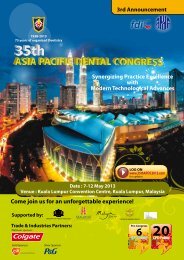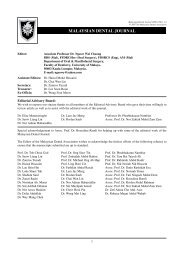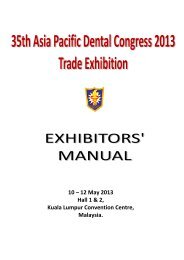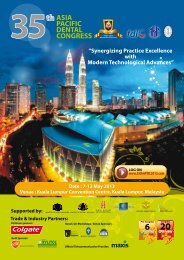PDF( 8mb) - Malaysian Dental Association
PDF( 8mb) - Malaysian Dental Association
PDF( 8mb) - Malaysian Dental Association
You also want an ePaper? Increase the reach of your titles
YUMPU automatically turns print PDFs into web optimized ePapers that Google loves.
Chong / Lim / Seowspecimens. Instrumental colorimetry warrants quantitativeevaluation and comparison of colour changes of materialsand eliminates the subjective interpretation of visualcolour comparisons 12 . Reflection Spectrophotometer wasutilized in the present study as it has the ability to measurethe reflectance of light within the entire visible spectrumand the measurements can be cross-referenced to existingshade guide, so there is immediate clinical relevance to thenumeric data generated.Tobacco use and certain dietary habits (coffee, tea,carbonated drinks consumption) may contribute to externaldiscolouration of composite resins 3, 13 . Discolourationand marginal degradation were two main reasons whyrestorations were replaced 14 . Coffee is a commonlyconsumed beverage worldwide including in Malaysia.Coffee solution has been investigated in various studiesand found to have the ability to stain composite resins4, 13,15, 16, 17. Um and Ruyter 17 suggested that coffee may stainby adsorption and adsorption of its colourants onto/into theorganic phase of composite resins.It has been stated in the literature that 24 hoursstorage time of the specimens in soaking medium simulatedconsumption of the respective solutions over 1 month 15 , 17 .In the present study, 3 days were chosen as the periodof immersion for the specimens to simulate the effect ofcoffee consumption in a long term period (approximately3 months). The results are expected to be accentuated bythe continuous immersion. The actual staining effect in theoral cavity would need a longer period of time because ofdaily oral hygiene procedures, dilution by saliva and thevariation in individual dietary habits. However, the resultscan provide an indication of the staining susceptibility ofthe various types of composite resins investigated.In the present study, great care was taken to minimizevariation in the brushing of the specimens, a standardizedload of 175g was mounted on the electric toothbrush toimpart a constant load. This load was the approximate forceused in routine daily brushing 10 . The distance between thebristle head and specimen was also measured with a caliperduring each placement of specimen in the specimen holderto ensure similar loading for each specimen. The dentifriceslurry was prepared based on study done by Teixeira et al. 18by mixing each type of dentifrice with distilled water at aratio of 1:1 by weight and thus producing three types ofdentifrice slurry for brushing. This is to simulate effect ofdilution by saliva. Pfarrer and White 19 prepared the slurrymixing the dentifrice with distilled water at a ratio of 1:3by weight. However, it was found that the dentifrice slurryprepared by the ratio of 1:3 was too diluted and wateryduring the pilot study. Thus, the ratio of 1:1 by weight wasemployed in the main study.After immersion in coffee, Beautifil showed the mostsevere colour changes and Filtek Z350 the least amongstthe three materials tested. The structure of composite resinsand the characteristics of the particles have direct impact onthe surface smoothness and the susceptibility to extrinsicstaining 5, 20, 21 . Average particle size of the primary fillers inFiltek Z350 was in the nanometer range (5-20nm), whereasthose of Filtek Z250 and Beautifil were in the micrometerrange (0.01-3.5µm and 0.01-5.0µm respectively). Owingto the smaller filler particle size of Filtek Z350, thesurface produced after polishing was smooth, thereforethe potential to retain stains was reduced. Similar findingswere found in the study carried out by Sumita et al. 22 .They had developed nanocomposites from nanofillersand measured the nanocomposite’s properties in vitro incomparison with hybrids, microhybrids and microfill. Inaddition, the findings in the present study are supportedby Lu et al. 4 who found that surface roughness (Ra) hada positive linear relationship with the colour changes ofcomposite resins tested, the smaller Ra i.e. the smootherthe surface, the less discolouration (the more resistance tostain) of the material. Therefore, Filtek Z350, a nanofilledcomposite was less susceptible to staining than FiltekZ250, a microhybrid composite where the filler particlesare considerably larger than nano-sized particles.The resin matrix also played an important rolein susceptibility to staining via surface adsorption andabsorption mechanism. Both Filtek Z350 and Filtek Z250used urethane dimethacrylate (UDMA) in its resin matrixsystem which has better colour stability compared toGiomer which used TEGDMA (with poorer colour stability)in its resin matrix system 15 . The urethane dimethacrylatematrix has lower viscosity, lower water sorption andgreater toughness. Giomer contains more organic matrixthan composites, thus increase their susceptibility towater absorption and the hyrogel layer of the glass filterrendered its hydrophilic properties which cause surfacedisintegration in the aqueous environment 23, 24, 25, 26 . Thiswould explain why Beautiful was the least stain resistant.Abundance of toothpastes/dentifrices containingdifferent formulations has been introduced in the market,with some trying to improve the efficiency of cleaning andpromoting tooth-whitening 19 . The whitening dentifrices canact in two different ways: physically remove superficialstain by the action of the abrasives or act chemically bythe effect of peroxides 27 . The present study found that therewas no difference between the regular toothpaste (ColgateTotal) and the whitening toothpastes (Colgate AdvancedWhitening and Darlie All Shiny White) in terms of theability to remove stains from discoloured composite resinmaterials. Although it is not totally clear how abrasivenessof a toothpaste can specifically affect the discolouredtooth surface, it would be expected that the abrasivenessact by reducing or eliminating extrinsic stains 27 . Based onthe formulation of the whitening toothpastes investigatedin the present study, it would appear that the dentifricesremove stains primarily based on abrasive action. Ourfindings correlate with the results achieved by Amaral etal. 27 , which explained that the incorporation of abrasivesin specific dentifrices might help physically in removingstains but since all the toothpastes in our study containabrasives, some degree of stain removal may be expectedeven with the regular toothpaste i.e Colgate Total.However, Yankell et al. 28 and Sharma et al. 29 reported thatwhitening dentifrices exhibited superior stain removal101
















